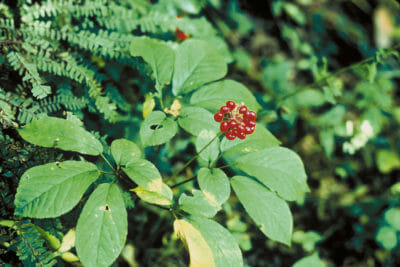
Ginseng, in Chinese, means “man root.” The miracle herb was first discovered thousands of years ago, and has been used as a powerful medicinal supplement for just as long. Likely, it was named as such because the roots of the plant look like a man’s legs. However, there is absolutely no denying that ginseng is one of the most beneficial herbs for man, making it an aptly named miracle plant.
Early Chinese emperors used ginseng as a remedy for illnesses of all kind, using it in cooking as well as in soaps, lotions, creams and other remedies. Its reputation quickly spread to western civilization as new land was settled and countries established. By the mid-1970s, American ginseng was listed as an endangered species. Due to its overwhelming popularity as a home remedy, the herb had been over harvested to near extinction.
Uses
While the threat of extinction was real, the reasoning behind the zealous hunt was valid: Finseng is widely sought after for its ability to restore overall health and is one of the most popular herbal remedies. Both American ginseng (Panax quinquefolius, L.) and Asian ginseng (P.Ginseng) are believed to increase energy, lower blood sugar and cholesterol, induce relaxation, and reduce stress, among other miraculous powers.
Ginseng may even make you smarter. A study conducted at the Medical School of Nantong University indicated that ginseng has beneficial effects on cognition and behavior.
Fast, All-Natural Pain Relief With No Nasty Side Effects!
Furthermore, ginseng might save your life. Some studies in Asia have indicated that the herb’s consumption is linked to a lower cancer risk, likely because the herb has strong anti-inflammatory properties.
Harvesting Ginseng
Many farmers now cultivate the delicate herb, helping to contribute to the rising ginseng trade. It can also be harvested from the wild, although it’s necessary to research your area’s laws and regulations regarding the herb.
Wild ginseng harvesting is regulated in 19 states, including Alabama, Arkansas, Georgia, Illinois, Indiana, Iowa, Kentucky, Maryland, Minnesota, Missouri, New York, North Carolina, Ohio, Pennsylvania, Tennessee, Vermont, Virginia, West Virginia and Wisconsin. Other states restrict or completely ban ginseng harvesting. The ginseng harvest season is usually September 1 to November 30; make sure you research your state’s individual laws. Ginseng can be found in most hardwood forests of North America, from southern Canada, east to South Dakota and Oklahoma, and as far south as Georgia. Typically, it grows in shaded areas (usually north or east-facing slopes). The more mature a forest is, the more likely it is that ginseng will flourish. It is also more likely to occur in forests containing beech, maple, hickory, oak, basswood, and tulip poplar trees.
If you plan to harvest ginseng, head out early in the season. You are less likely to find it as the fall months go on. Ginseng can typically be found growing in deep, dark soil with an ample amount of leaf litter. It often grows near companion plants such as trillium, cohosh, bloodroot and goldenseal.
There are 11 different varieties of ginseng, all of which are short, slow-growing perennials with full, fleshy roots. Roots are light-colored and forked and accompany a long stalk with green, oval-shaped leaves. The plant will have a single stem, each ending with a whorl of one to four leaves. Each leaf has an additional set of smaller leaves. Mature plants, at around five years old, will also host brilliant white-green flowers and red berries.
 Don’t harvest a ginseng plant that does not have berries. These plants are not mature, and will not produce the desired effects. In many states, harvesting ginseng before this time is illegal, and immature ginseng won’t provide the same health benefits as mature ginseng. If you are harvesting wild ginseng, it’s also wise to replant the berries as you go, to allow nature to take its course and reproduce new ginseng.
Don’t harvest a ginseng plant that does not have berries. These plants are not mature, and will not produce the desired effects. In many states, harvesting ginseng before this time is illegal, and immature ginseng won’t provide the same health benefits as mature ginseng. If you are harvesting wild ginseng, it’s also wise to replant the berries as you go, to allow nature to take its course and reproduce new ginseng.
If you’re fortunate enough to find a mature ginseng plant, carefully remove the plant by its roots so that you don’t damage the neck. Use a spade to dig beneath the plant and leave space between the plant and where you push the spade into the ground.
Drying Ginseng
When you get the plant (or, if you’re fortunate, plants) home, soak the roots in a bucket of cool water to remove excess dirt. Place the roots on a tray or screen to dry, with space between them so that they do not touch. Make sure the room is well-ventilated and between 70 and 100 degrees Fahrenheit.
Whatever you do, don’t attempt to dry the roots in the oven or direct sunlight. This can severely damage them. Roots generally take about one to two weeks to dry, and will snap apart cleanly when ready.
If you plan to sell or export your ginseng, you will need to purchase a license. If the plants you harvested are not at least five years old and fully mature, they are considered illegal. Make sure you do the proper research before harvesting!
Enjoying Ginseng
Ginseng root can be eaten whole or included in supplements, teas or other forms. Ginseng tea is extremely popular, and actually helps make the immune system and metabolism work more effectively.
Though this miracle herb is generally safe for most to consume, over-consumption can lead to side-effects such as headaches, difficulty sleeping, nausea, and an elevated heart rate. As a result, we recommend consuming ginseng in moderate quantities, and, of course, ceasing its use if you experience any negative effects.
What advice would you add? Share your tips in the section below









